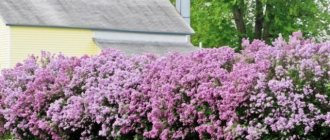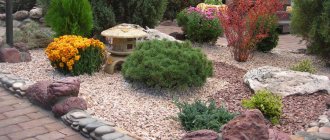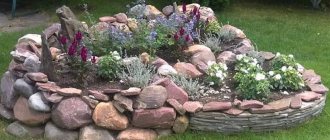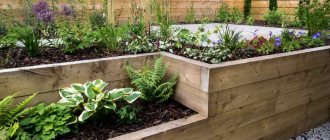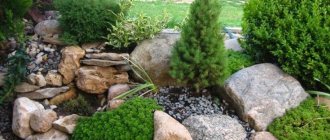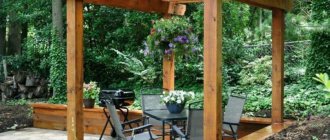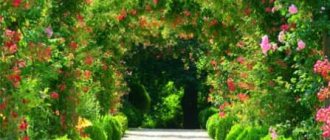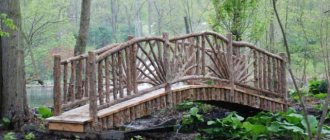Review author: Terrari School of Design
Rock gardens in landscape design are one of the most popular solutions. Many modern summer residents strive to create this complex structure on their plots, because regardless of size, a stone garden can add variety to even the most boring environment.
However, organizing such a flower garden requires taking into account a lot of nuances. A rockery is a composition of stones and plants that serves as decoration for a garden or yard. Tree and shrub forms, flowering plants, and cereal crops can act as plant filling.
Rocky flower beds look most impressive on terraces and slopes. The installation of an artificial hill is acceptable.
Rockery and rock garden: what is the difference
These landscape elements have many similarities with each other. Both are considered rock gardens. If a rock garden is created to imitate a mountainous terrain with the presence of a mandatory hill, then its opponent is most often located on a plane without a slope. In rock gardens, plants that grow in alpine zones are mostly used for planting.
For rockeries, different vegetation is used, including shrubs, conifers, and ground cover. In terms of area, alpine slides do not take up much space, but rather large areas can be allocated for rocky gardens, where the decorative background is inanimate nature - stones.
Coniferous fencing
In landscape design, coniferous trees are used not only for decorative purposes, but can also have useful functionality if planted as hedges. They can be either the main fence of the site or divide it into zones. In the first case, tall varieties of conifers are used, in the second, dwarf varieties and shrubs. In addition, birds can build their nests on such fences and subsequently perform an excellent service by destroying pests.
Coniferous fencing
As a rule, for these purposes, conifers are grown separately, in special arboretums. But sometimes you can find suitable seedlings in ordinary flower shops. In pursuit of a unique design, you should not look for some rare breeds of conifers; pine, spruce and larches are quite suitable for high hedges, and thuja and juniper bushes for lower ones.
Coniferous fencing
What types of rockeries are there?
On your own summer cottage you can create one of the following types of rockeries:
- stable;
- temporary;
- volatile.
A stable one will delight you with its beauty for more than one season. Both small and large stones are used for it. Slow-growing conifers and low-growing shrubs are planted.
Temporary is established for one or two seasons, so perennials and large, bulky blocks are not used for it.
A variable garden is a small area where several large crops are planted and smaller ones are replanted annually. That is, every year the landscape changes depending on the wishes of the owners.
On the slope
Looks good where there is a natural depression in the ground. The slopes are strengthened with buried boulders, between which low-growing conifers, bergenia, hostas, and creeping plants are planted. A wonderful addition to such a garden is a waterfall or artificial spring.
If there is no soil slope, you can create it yourself or build a terraced rock garden. It consists of retaining walls made of stone blocks stacked on top of each other. Elevations must be durable and include areas for planting. The larger the building, the more impressive the composition and cascading plantings look.
Any summer resident can cope with the creation of most types of rockeries. With minimal care, this corner of your garden will always please the eye.
Varieties of styles
There are many styles for organizing a rock garden. Each of them has its own characteristics that need to be taken into account when creating.
Japanese
The beauty of the stone details, arranged incredibly harmoniously, comes to the fore here. A minimal amount of vegetation, both planted and potted, decorates the garden. Often in the Japanese style of flower garden design, lighting and decorative objects are used.
Scandinavian
The harsh style, inspired by Scandinavian nature, assumes the presence of conifers and low-growing integumentary plants. In this case, decorative elements come to the fore - figurines of animals and birds, candlesticks, figurines. Originality and beauty are achieved through additional elements and conifers, which play the main landscape role.
European
The design is similar to an alpine slide, as beautifully flowering crops are used. These are alpine and herbaceous perennials, deciduous shrubs. During the warm season they replace each other.
Italian
Has a strong resemblance to a rock garden. But the rounded and smooth lines of boulders, sculptures and forged furniture give a special aesthetics. The design is very subtle to perceive; the Italian-style flower garden has a unique grace.
English
The English style is distinguished by a variety of cultures, which gives the territory a special landscape. Cereals and conifers, decorative foliage and bright flowers are widely used here, which are surprisingly combined with each other.
German
Precision placement of stones, clearly planted plants, neatness, cleanliness from weeds and foreign objects are characteristic of a German garden. For this purpose, flat stones and even strict stone structures are chosen. Among ornamental crops, preference is given to unpretentious ones that can delight with beauty in any weather.
American
American-style rockeries are often created in groups. They decorate areas in the yard, the entrance to the house and other places where design techniques remain visible. There are no strict rules for American design - landscape elements are selected depending on the preferences of the owners.
Mexican
Rare design for Russian climatic zones. It is characterized by the presence of flowering cacti framed by peculiar stone details against the backdrop of a bright blue sky and endless yellow steppes.
Tropical
Originality, splendor and brightness of colors are inherent in tropical compositions. Large shrubs and beautiful flowers are used here. Powerful leaves and large inflorescences among the stone blocks look very good, being a separate landscape element of the landscape.
Rockery stones
The main details of a rock garden are still stones. The main rule when choosing is uniformity. Since the composition in an open area is visible from all sides, the stones are selected carefully. One incorrectly selected specimen disrupts the harmony of the entire flower garden.
The selection of specific stone details is carried out within the landscape line used. For example, if the garden is created with a bias towards a rocky landscape, then the stones should be angular, rough and rough. Massive boulders mixed with gravel are perfect. The rockery with a pond will be decorated with polished, rounded small boulders and pebbles.
Real photos of rockeries made by yourself
To make a rock garden at your dacha, you don’t have to hire the services of professional landscape designers. You can think through everything and do it yourself. Proof of this are examples of rockeries made by the hands of amateur gardeners.
A small rock garden with unusually selected stones and laid in the shape of a pattern.
Rockery with multi-colored backfill laid out in patterns.
A rockery with driftwood, located near the summer house.
A dry stream in an ensemble with a small rock garden.
A stone garden, decorated with a small architectural form in the form of a decorative mill..
A rockery that includes a structural tree in its composition.
Stone garden created during self-isolation.
A classic rock garden decorating a recreation area.
A true connoisseur of rockeries.
Dry lake with an island in the form of a rock garden.
Plants for rock gardens
Design compositions are decorated with unpretentious plants - ground cover, shrubs, conifers. One or two varieties are selected from each group, planted in separate zones or grouped. The principles for selecting crops are based on low growth rates and not overcrowding the flower garden with a variety of shapes and species.
Important - for 10 sq. m of rocky garden, 12 species of plants are planted, similar in growing conditions.
Conifers
Small coniferous trees - spherical spruce, thuja, miniature cypress, juniper, dwarf pine.
Shrubs
Shrubs should be chosen that are neat and compact. For this, honeysuckle, cotoneaster, and cinquefoil are used. Jasmine, Iberis, and cultural aubrieta are also used for rockeries.
Perennials
Herbaceous and bulbous varieties are planted both individually and together in groups. Burdock, ivy, climbing rose, aurinia rock, carnations and other perennials look great with lawn grass. For such a rock garden, an irregularly shaped area is allocated.
Ground cover
They prefer ground cover crops with pale inflorescences and sparse flowering. For example, phlox, Caucasian rhizome, edelweiss or cat's paw. Plants in this case emphasize the aesthetics of the stone blocks.
Floral
The main part of such a rockery consists of ground cover herbaceous perennials with abundant flowering, as well as creeping plants. They blend harmoniously with stones and pebbles, arranged in groups or carpet spots. To form the composition, you can use stone blocks that rise slightly above the flowers.
The colorful flower garden is made up of tenacious, arabis, young and fern. You can also plant annual plants: lobelia, purslane, petunia.
How to make a rockery yourself
If you take into account the advice of landscape designers and study the topic, then it is quite possible to create a rocky flower garden yourself. This is an amazingly interesting, creative process in which you can immerse yourself headlong and gain invaluable experience in the practice of landscape design.
Selecting a location
It should be located in a visible place - an open area, near the house or in a recreation area. Along a garden path or on a slight slope or natural unevenness, the original flower garden looks natural. It must fit harmoniously into the general topography of the territory. It is better to choose a sunny place, but if you plan to plant conifers, then the flower garden is located in partial shade.
Planning
The creative process begins with the creation of a detailed diagram, where all stone details and vegetation are numbered. It is important to remember that the most spectacular blocks are located in the center of the rock garden, which forms its basis. The rest of them are located around the perimeter. Tall stones are installed in the center with an open rockery arrangement. If it is placed near a wall, then tall specimens are placed on the sides or in the background.
The diagram is drawn using a grid with cells 1 to 1. In reality, when delimiting the site, you will need to draw a grid with cells of 50 by 50 cm, which will correspond to the analogue on the plan. This will allow you to distribute all design elements as accurately as possible.
Site preparation
In early autumn they begin to prepare the site. The top layer of soil is removed, carefully removing the rhizomes. In a low-lying area, a drainage cushion is installed with the addition of sand. If the place is dry, then there is no need to do drainage. After this, the site is carefully compacted, paying the greatest attention to the areas where large boulders will be located. It is better to pour a concrete foundation under them to ensure fixation. The area is covered with agrofibre and covered with sand. Spread a suitable soil composition.
Installation of stones
The process is carried out in accordance with the diagram. First, the largest specimens are placed, which are dug into the ground, then, according to the plan, the small ones are laid out. Each of them must lie firmly, not wobble or move.
Planting
For each crop, small holes are made between the blocks and spilled with water. The interval between tall plants is 15-20 cm, between low ones - 5-10 cm. High ones are placed in the foreground, and low ones are placed in the background.
Filling free space
All free space is covered with pebbles or fine gravel, a layer of 10-15 cm. When blurred, the material is added.
video on how to create a rock garden
Site preparation
In order for the plants in your stone garden to feel good, you need to create all the necessary conditions for them - carefully prepare the site. To do this, remove all the turf to a depth of 20–30 cm. It is better to fold the removed layer separately and then use it to prepare the soil mixture. Remove weed roots completely.
If the area chosen for the rock garden is located in a lowland and gets very wet during rains and floods, then it is necessary to arrange drainage. Broken brick, expanded clay, pebbles or gravel may be suitable for drainage. The thickness of the drainage layer is 15 cm for a garden with large stones and 10 cm if you do not plan to work with large stones.
If the area is not flooded, there is no need to do drainage, but the bottom of the rock garden is covered with geotextile or black lutrasil.
It is reasonable to spread a metal mesh with small cells on the bottom of the rock garden. The mesh will protect the plantings from rodents.
When laying large boulders, it makes sense to build a foundation for them. Then the stones will not “go” into the soil and lose their given height. The foundation can be made of concrete and should be approximately 10 cm below the soil surface.
A layer of sand is poured onto the geotextile so that the rockery stones do not mix with the ground. The sand layer depends on the size of the stones and ranges from 5 to 15 cm.
Cross-sectional diagram of a rock garden with one large boulder.
This completes the work with the foundation structure and all that remains is to fill in the layer of earth. The soil should be loose, light and fertile. To obtain such soil, you can use a layer of turf that we removed from the surface of the site, knead it thoroughly and mix it with sand, compost and peat. If the plants of your rock garden are demanding on soil acidity, you need to add limestone or dolomite flour to the soil. Small pieces of broken red brick added to the soil can absorb water and then release it when the soil dries out.
The main mistakes when arranging rockeries
Mistakes to avoid:
- Do not use construction waste for drainage, only gravel, sand and soil;
- stones are selected in different sizes, but of the same shape - this will make the composition harmonious;
- there is no need to use boulders of the same size, laying them out in a strict, rhythmic order - there is no such arrangement in nature.
If a small area is selected, then you can recreate all the naturalness of the natural composition, but only in miniature.
Ideas for a rock garden
As design practice shows, there are many ideas. You can create a composition in the style of a Japanese garden, where the main attention is paid to the selection of plants. Bog with water lilies - perfect for wetlands, Alpine flower garden - with flowers characteristic of the Alps (edelweiss, saxifrage) or Rocky Hill with impressive large boulders and small vegetation between them.
There are a lot of ideas for creation, it all depends on the landscape features of the site and the preferences of the owners.
Rockery with pond
A decorative recreation area with a pond looks harmonious if the pond and rock garden are approximately the same size. You should not use artificial stone parts, which in this case do not look natural. Sandstone, limestone, and stones from natural reservoirs are suitable. Saxifraga, heather, alyssum, and watersheds are planted here. It is better to “scatter” tall shrubs individually, and plant ground cover between boulders, near a pond.
Rockery on the slope
When arranging such a composition, the slope must be oriented to the south or southwest side. Stones should be laid in groups, leaving sufficiently large spaces between them. A completely blocked slope looks cumbersome. Large flower beds with steps are set up on the slopes, along which hanging flowers will hang and low-growing crops will be grouped in groups.
Rockery with conifers
A composition with conifers can be located both on a plane and on a slope. Here you should maintain the optimal distance between shrubs and trees when planting. Small vegetation is used as additional elements. For example, a garden with coniferous trees, which is decorated with bright flowers, looks interesting. But there should be few of the latter, because the main emphasis in this case falls on conifers.
Alpine lawn
A real corner of nature, which is associated with the high Alps, is a rock garden lined with stones reminiscent of rock fragments, combined with carpet saxifrage, edelweiss and carnations. A minicopy of an alpine meadow, unlike a rock garden, is located on a fairly flat area and should not be exposed to sunlight.
How to care for a stone composition
The main agrotechnical care methods are:
- pruning overgrown shoots, removing dried leaves and stems;
- replanting new crops in spring instead of those that froze in winter;
- fertilizing, if required, adding limestone to crops if the soil is alkaline or neutral;
- adding sand, soil or pebbles in places where the embankment is eroded;
- replanting annuals in free spaces - gypsophila, iberis and others;
- weeding, watering and mulching the soil.
A properly equipped rock garden will not require much effort and time to maintain. Initially, it is worth selecting plants for it with uniform requirements for growing conditions. Then there will be no problems with maintenance and care.
